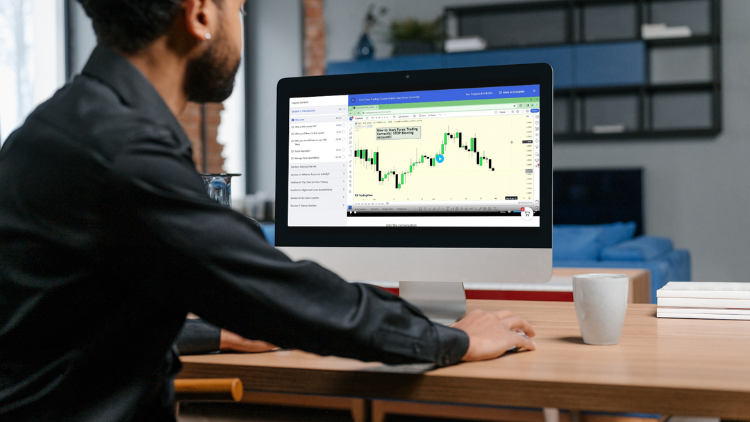Forex trading, or foreign exchange trading, is a global marketplace for exchanging national currencies. For beginners, understanding this dynamic and complex market can be overwhelming. This forex trading for beginners full course will break down the essentials of forex trading, offering a comprehensive guide to help you navigate and succeed in the forex market.

Introduction to Forex Trading
What is Forex Trading?
Forex trading involves buying one currency while simultaneously selling another. These currency pairs fluctuate in value based on economic, political, and social factors. The goal is to predict these fluctuations and trade accordingly to make a profit.
Why Trade Forex?
Forex trading offers several advantages:
- High Liquidity: Forex is the largest financial market in the world, with daily trading volumes exceeding $6 trillion.
- 24/5 Market: Forex trading is open 24 hours a day, five days a week, allowing for flexible trading hours.
- Low Costs: Forex brokers usually charge low or no commissions, relying on spreads (the difference between the bid and ask price) instead.

Full Trading Course 90% OFF
Getting Started with Forex Trading
Setting Up a Trading Account
- Choose a Broker: Look for a reputable broker with a good track record, regulatory compliance, and competitive spreads.
- Open an Account: Register and provide the necessary documentation to verify your identity.
- Fund Your Account: Deposit funds into your trading account using your preferred payment method.
Understanding Forex Terminology
- Currency Pair: Represents the two currencies being traded, e.g., EUR/USD.
- Pip: The smallest price movement in a currency pair, typically 0.0001 for most pairs.
- Leverage: Borrowed funds that allow you to trade larger positions than your actual capital.
- Spread: The difference between the bid and ask price of a currency pair.
Using a Trading Platform
Most brokers provide trading platforms such as MetaTrader 4 (MT4) or MetaTrader 5 (MT5). These platforms offer various tools and features to facilitate trading, including charting tools, technical indicators, and automated trading options.
Fundamental Analysis in Forex
Economic Indicators
Economic indicators are vital for understanding currency movements. Key indicators include:
- Gross Domestic Product (GDP): Measures a country’s economic performance.
- Inflation Rates: Higher inflation usually leads to currency depreciation.
- Employment Data: High employment rates generally indicate a strong economy and currency.
- Interest Rates: Central bank policies on interest rates can significantly impact currency values.
Political and Geopolitical Events
Political stability, elections, and international relations can influence forex markets. Traders must stay informed about global news and events to anticipate market movements.
Technical Analysis in Forex
Chart Types
- Line Chart: Connects closing prices over a specific period.
- Bar Chart: Displays the open, high, low, and close prices for each period.
- Candlestick Chart: Similar to bar charts but with a more visual representation of price movements.
Key Technical Indicators
- Moving Averages: Smooth out price data to identify trends.
- Relative Strength Index (RSI): Measures the speed and change of price movements.
- Bollinger Bands: Indicate volatility and potential overbought or oversold conditions.
- Fibonacci Retracement: Helps identify potential support and resistance levels.
Support and Resistance Levels
Support levels are where prices tend to stop falling, while resistance levels are where prices tend to stop rising. Identifying these levels can help in making informed trading decisions.
Developing a Forex Trading Strategy
Risk Management
Effective risk management is crucial for long-term success in forex trading. Key strategies include:
- Setting Stop-Loss Orders: Predetermined points at which to exit a losing trade to prevent further losses.
- Using Proper Position Sizing: Determining the size of each trade based on your account size and risk tolerance.
- Diversifying Your Trades: Avoid putting all your capital into a single trade or currency pair.
Trading Styles
Different trading styles suit different personalities and schedules:
- Scalping: Involves making numerous small trades throughout the day to capture minor price movements.
- Day Trading: Trades are opened and closed within the same day, avoiding overnight risk.
- Swing Trading: Involves holding positions for several days to capture larger price movements.
- Position Trading: Long-term approach, holding trades for weeks or months, based on fundamental analysis.
Backtesting and Demo Trading
Before committing real money, it’s essential to test your trading strategy. Backtesting involves applying your strategy to historical data to see how it would have performed. Demo trading allows you to practice in a simulated environment using virtual money.
Common Mistakes to Avoid
Overtrading
Trading too frequently can lead to increased transaction costs and emotional trading, which can negatively impact your performance.
Lack of a Trading Plan
Having a well-defined trading plan helps maintain discipline and consistency. It should outline your goals, risk tolerance, trading strategy, and criteria for entering and exiting trades.
Ignoring Risk Management
Failing to implement proper risk management can lead to significant losses. Always use stop-loss orders and never risk more than a small percentage of your trading capital on a single trade.
Chasing Losses
Trying to recover losses by taking larger, riskier trades often leads to further losses. Stick to your trading plan and risk management rules.
Continuing Education and Improvement
Forex Trading for Beginners Full Course

Full Trading Course 90% OFF
Tired of going back and forth in trading? Or are you tired of watching countless YouTube videos that gets you more confused than you were? Just get this course… you’ll be happy you did!
Books and Online Resources
Numerous books and online resources offer valuable insights into forex trading. Some recommended reads include:
- “Currency Trading for Dummies” by Brian Dolan
- “Forex Trading: The Basics Explained in Simple Terms” by Jim Brown
- “Trading in the Zone” by Mark Douglas
Practice and Experience
Like any skill, forex trading requires practice and experience. Continuously refine your strategies and learn from your mistakes. Join trading communities and forums to share experiences and gain insights from other traders.
Conclusion
Forex trading can be a profitable venture if approached with the right knowledge and discipline. This full course provides a solid foundation for beginners, covering everything from setting up an account to developing trading strategies. Remember, the key to success in forex trading lies in continuous learning, disciplined risk management, and emotional control.
By following this comprehensive guide on forex trading for beginners, you’ll be well-equipped to navigate the forex market and work towards achieving your financial goals. Happy trading!


